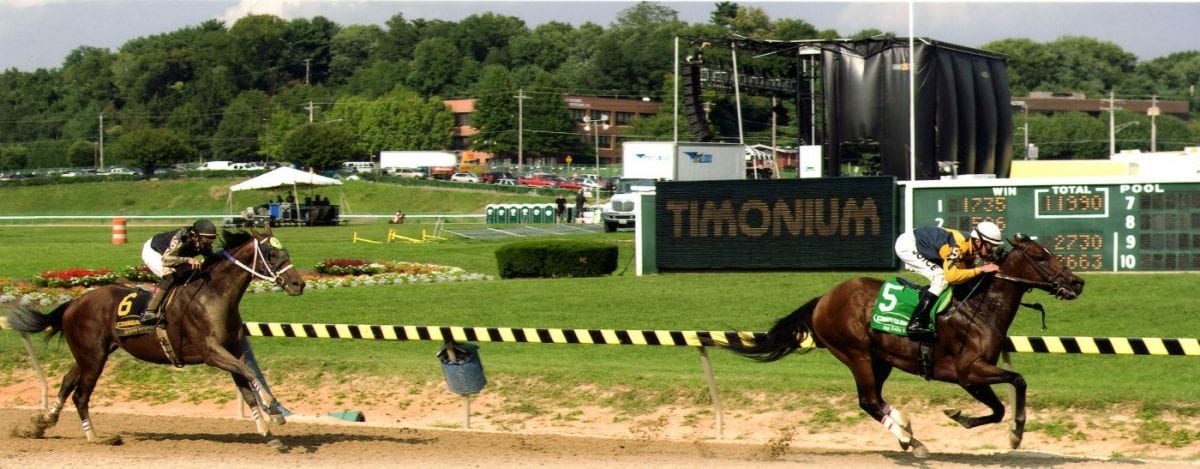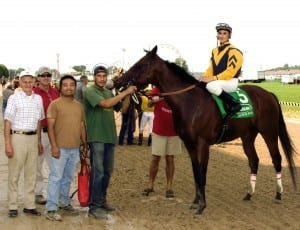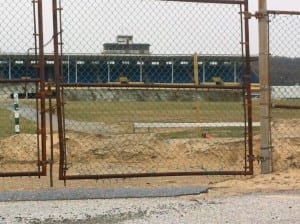by Frank Vespe
“You can’t help but feel upbeat when you walk into the grandstand at Timonium,” racing fan and blogger Kevin Martin opined a couple of years ago on his Colin’s Ghost blog (here).
He’s not alone in feeling that way, and perhaps that’s why the Maryland Thoroughbred Horsemen’s Association (MTHA) has cast its eyes so longingly in the direction of the Big T. Earlier this year, the MTHA had legislation introduced which
would have allowed Timonium to host 25 days of live racing, up from the 10 currently permitted by state law; in recent years, because of sparse purse money, Timonium has scheduled just seven days of live racing. That legislation has gone nowhere.
So at its June 24 meeting, the MTHA board used its only other Timonium tool: it voted to spend an estimated $600,000 from the purse account to enable the state fair track to run its full allotment of 10 days this summer. About $450,000 of that amount will go to purses for the three additional days, and $150,000 will be a payment to the State Fair to cover its anticipated losses for adding three more racing days.
Now the hard part: filling 10 days on a five-furlong bullring and ensuring the expenditure of funds is a wise investment.
“No idea”
“We didn’t have any idea that this was going to be introduced at the meeting,” said MTHA board member Michael Horning. “There were no supporting materials provided to us before the meeting.”
Horning was one of three board members, of the nine present, who opposed spending the money to expand the Timonium meet. He was unwilling, he said, to support the measure without having sufficient data to judge whether it made economic sense.
Moreover, he pointed out, the coming year to 18 months will be something of a challenge for the MTHA to steward the purse account. In 2014, the main body of the 10-year agreement among the horsemen, racetracks, and breeders kicks in. That will mean a) that the tracks will run only 100 days, with the horsemen required to buy any additional they want; and b) that the split of takeout will shift in a way that reduces the horsemen’s share.
Such an environment demands greater accountability and certainty — not less — and Horning described the process (or lack thereof) leading to the decision as “pretty bad.”
In truth, one can question whether this is a wise investment. During its six days of live racing last year — one was lost to the weather — Timonium’s average daily handle on the live product was about $430,000, according to Equibase charts. That amounts to less than one-third of the average handle on the live product during the past winter’s Laurel meet. And all of Timonium’s racing took place on weekends and a holiday; the additional three days will come mid-week, which figures at least to put a damper on live handle.
According to multiple people present at the June 24 meeting, the MTHA estimated that its share of the handle would amount to around $60,000 per day. Assuming that proves to be the case, that would make the total investment in three extra days around $420,000.
“Tremendous part of our history”
[pullquote]Racing is a tremendous part of our history.”[/pullquote]“We’re all upbeat about [adding three more days],” said Maryland State Fair president and general manager Max Mosner. “Racing is a tremendous part of our history.”
One of the arguments in favor of adding days to Timonium — which once was part of a thriving Maryland fair circuit and into the 1980s hosted a full, 42-day summer meet — is simply that people like it. And there’s more truth to that than gross handle figures would suggest.
In fact, what drags Timonium’s handle down is its weak presence in the simulcast market; bettors elsewhere aren’t much interested in the steady diet of cheap races and cheap horses circling the York Rd. bullring. Timonium’s daily export handle was about one-sixth of Laurel’s during the latter’s most recent meet.
But Marylanders and fair-goers do show an affinity for Timonium. The track reported daily attendance of about 2,500 last year, which occupies a significant portion of the old grandstand. And, while 2,500 at most tracks would break out to a couple hundred watching the live races and a couple thousand watching the simulcasts, at Timonium the reverse is true.
As a result, Timonium’s on-track handle on its live product was a solid $135,000 per day — comfortably ahead of Laurel’s recent numbers. That suggests that at least a local market for Timonium’s product exists; it also suggests that Maryland’s horsemen should look for ways to turn fair race-goers into year-round racing fans.
Mosner said that the State Fair’s goal had always been to return to using its allotted 10 days for racing. With the MTHA showing a reinvigorated interest in Timonium, that goal is set to occur.
“Very difficult”
Georganne Hale, racing secretary at Timonium and at both Laurel and Pimlico, is expecting her job at Timonium to be “very difficult,” she said. “I think we will have some problems filling races for 10 days straight.”
That’s in part a result of the added days and in part due to challenges endemic to Timonium.
Some Marylanders like to run at Timonium, Hale explainded, so they target the meet with horses who figure to like the bullring; they map out the horses’ schedule to enable them to hit a race in each weekend. Indeed, forty-one horses made two starts last year during the brief meet.
That’s fine, as far as it goes. But who will fill the three intervening weekdays?
Hale needs it to be Maryland horsemen. “I’d like them to please support the meet,” she said with a chuckle. “The MTHA chose for the 10 days,” she added, suggesting that it would be incumbent on the state’s horsemen to support a meet that they wanted.
One thing that will help will be purses. They will increase roughly 50 percent this year, to an average of about $150,000 daily. That will enable Hale to card first-level allowance races for perhaps $32,000, she said — less than 80 percent of a similar race at Laurel, but an amount that will compare favorably with the region’s other bullring, Charles Town.
Another is the trainer bonus; the MTHA annually awards up to $10,000 to the meet’s leading trainers by wins and starters, which has the effect of keeping some of the state’s biggest barns involved. Last year’s top three trainers by wins were Jamie Ness, Hugh McMahon, and Dale Capuano; all have sizable operations and have won meet titles at Maryland’s so-called “mile tracks.”
Yet the very existence of that bonus points to Timonium’s ongoing challenge: some horsemen don’t like to run there. Among the reasons Hale has heard: that the turns are too sharp, the track too short, and that closers have no real shot. In addition, Timonium has no turf course, so that leaves many horses on the sidelines altogether.
Hale asserted that the racing strip itself is in very good shape and that the track’s turns, while tight, are sufficiently banked. Still, she acknowledged the issue.
Last year’s Timonium races drew an average field of just over seven horses — fewer than any other Maryland meet. Races during the meet’s first weekend averaged more than 7.5 horses; that number fell to about 6.7 in the second weekend.
This summer, for the first time in several years, Timonium will race for all 10 of its allotted days. You can expect enthusiastic crowds cheering their chosen horses, the smell of tasty foods that are bad for you wafting over from the fair, and the sight of the Ferris wheel looming in the background.
As to questions of handle, field size, or the wisdom of the investment, well, we’ll have to wait and see on those.













I actually like the idea of an extended Timonium meet. I’m sure a lot of people might remember when the Big T had a Summer Meet with 40 days and competing with Delaware Park. The bigger outfits would stable and/or ship back & forth to DE, NJ and PA while the smaller outfits (as they still do) stay behind and support the MARYLAND program… I like the extra three days for two reasons. 1.) It gives the Mom & Pop stables who get hustled the rest of the year (just to fill a race) a chance to win a race or finish in the money. 2.) Even though the live days will occur in the middle of the week, the State Fair is still in progress and it will give Maryland racing more exposure to the Fair goers who might become curious and check out horse racing when they see or hear the horses running up the backstretch and around the far turn. Georgeanne is right, however, it would be incumbent on the state’s horsemen to support a meet that they want” I’m anxious to see!
The MTHA standard line “we’re doing it for the little guys.”- Of McMahon, Capuano and Ness,- which one is the “little guy”?
Often the horses competing have soundness issues and the Big T is the one place besides Charlestown where they are competitive. Couple that with trainers encouraged to enter the animal twice and even 3 times in the same meet yields increased probability of breakdowns irregardless of the track surface. Is this really the way to develop new fans?
I don’t recall the MTHA leadership asking the membership or the racing secretary if more days were desired. If the board feels it necessary to spend 600K why not give it to the Assistance Fund?
Thanks for checking in, Bobby and Pony. I wonder if the stats back up the notion that the little guys like Timonium -lots of people say it, but the meet leaders are the same guys who lead every other meet… which doesn’t make the notion false necessarily… but you’d like to know for sure.
Pony – are there #s that back up the idea that that there is an “increased probability of breakdowns” because of the factors you cite at Timonium?
Hey- I’ve got an idea- let’s count!
Am I reading this correctly ? The MTHA Board made a decision to spend $600,000 without providing the Board with financial data or previous notice that such an expenditure was to be considered ???? If am reading this wrong , please correct me. I would think that proper governance and fiduciary responsibility would dictate at least some due diligence prior to approving such a large expenditure.
Why can’t Timonium stay opened for Training after the sales are over? It certainly would help a lot of trainers who have to drive to Laurel and Bowie every day. The barns and track lay idle for a large portion of the year and for what purpose.
Pimlico will open for training year round when the barns are built at Laurel and Bowie is closed for good. 2014? 2015?
The current Governor is no fan of Horse Racing, but the present Lt. Governor strongly dislikes it. Has anyone invited Anthony Brown to spend several days at horse farms or training facilities? Does he understand the industry? Does anyone care? You will when he is elected Governor and a gaggle of Good Ole Boys try to waltz into his office and tell him how it is.
Be nice to know someone is thinking ahead.